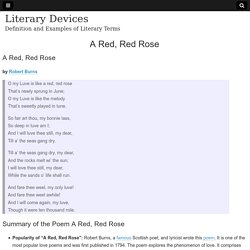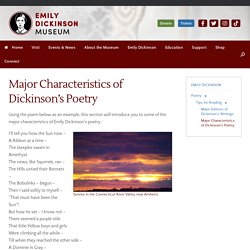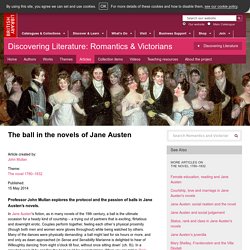

Love is in the air! - Good Morning Miss! Romeo and Juliet remixed: how technology can change storytelling. On Sunday, as part of the Sydney Opera House’s UnWrapped series, a group of dancers “remixed” Shakespeare’s Romeo and Juliet by way of an Australian storytelling technology, Omelia.

A product built to shuffle characters and events and generate narrative possibilities in real time, dancers using it brought a new version of the classic tragedy to life. The one-off production, R+J RMX, was filmed for the Opera House’s streaming platform. The “remix” was interactive: audience members were sent to a website where they could restructure the play with the touch of a button, while on stage narrators and dancers ran through numerous renditions of the story.
A Red, Red Rose Analysis - Literary devices and Poetic devices. A Red, Red Rose by Robert Burns O my Luve is like a red, red rose That’s newly sprung in June; O my Luve is like the melody That’s sweetly played in tune.So fair art thou, my bonnie lass, So deep in luve am I; And I will luve thee still, my dear, Till a’ the seas gang dry.Till a’ the seas gang dry, my dear, And the rocks melt wi’ the sun; I will love thee still, my dear, While the sands o’ life shall run.And fare thee weel, my only luve!

And fare thee weel awhile! And I will come again, my luve, Though it were ten thousand mile. Summary of the Poem A Red, Red Rose. Robert Burns. Robert Burns was born in 1759, in Alloway, Scotland, to William and Agnes Brown Burnes. Like his father, Burns was a tenant farmer. However, toward the end of his life he became an excise collector in Dumfries, where he died in 1796; throughout his life he was also a practicing poet. His poetry recorded and celebrated aspects of farm life, regional experience, traditional culture, class culture and distinctions, and religious practice. He is considered the national poet of Scotland. Although he did not set out to achieve that designation, he clearly and repeatedly expressed his wish to be called a Scots bard, to extol his native land in poetry and song, as he does in “The Answer”:
30 Best Love Poems of All Time - Most Romantic Love Poems. The end of the affair. Rapture by Carol Ann Duffy 62pp, Picador, £12.99 I read it on the tube, and missed my station.

I read it in bed, and couldn't sleep. I read it at my desk, and started to cry. How Love Stories Ruin Our Love Lives. Little Women (2019) - Marriage Is an Economic Proposition Scene (3/10) The History of Marriage. The history of marriage - Alex Gendler. How Marriages Have Changed Over The Last 100 Years. Hope for marriage may have seemed lost by the '30s, but World War II — and the subsequent "industrial boom"— brought with it a surge of matrimony.

By the 1950s, the United States was entering its so-called "golden age of marriage. " But, as the old Shakespearean adage goes, all that glitters is not gold. This would be especially true of the '50s marriage model. "People look back to that as the traditional family, but it was probably the only time in history when a vast majority of women did not work," Coontz told PRI. Major Characteristics of Dickinson’s Poetry – Emily Dickinson Museum.
Using the poem below as an example, this section will introduce you to some of the major characteristics of Emily Dickinson’s poetry.

Sunrise in the Connecticut River Valley near Amherst. I’ll tell you how the Sun rose – A Ribbon at a time – The steeples swam in Amethyst The news, like Squirrels, ran – The Hills untied their Bonnets – The Bobolinks – begun – Then I said softly to myself – “That must have been the Sun”! But how he set – I know not – There seemed a purple stile That little Yellow boys and girls Were climbing all the while – Till when they reached the other side – A Dominie in Gray – Put gently up the evening Bars – And led the flock away – (Fr204) 4 Love Poems (LLCE) by Pauline MENET on Genially. 4 Love Poems Love through the Ages Robert Burns.

Libmanuels. The graphs that show the search for love has changed. Pride and Prejudice: Mr Darcy Proposing Elizabeth. Ten key moments in the history of marriage. Jane Austen: Class and marriage. Proposals and Marriage in Jane Austen’s Novels. Summary of 'North and South' - Elizabeth Gaskell. The ball. Professor John Mullan explores the protocol and the passion of balls in Jane Austen’s novels.

In Jane Austen's fiction, as in many novels of the 19th century, a ball is the ultimate occasion for a heady kind of courtship – a trying out of partners that is exciting, flirtatious and downright erotic. Couples perform together, feeling each other’s physical proximity (though both men and women wore gloves throughout) while being watched by others. Many of the dances were physically demanding: a ball might last for six hours or more, and end only as dawn approached (in Sense and Sensibility Marianne is delighted to hear of Willoughby dancing ‘from eight o'clock till four, without once sitting down’ (ch. 9)). Courtship, love and marriage in Jane Austen's novels. Professor John Mullan explores the romantic, social and economic considerations that precede marriage in the novels of Jane Austen.

Professor Kathryn Sutherland discusses the importance of marriage and its relationship to financial security and social status for women in Jane Austen’s novels. Filmed at Jane Austen’s House Museum, Chawton. It is right that the three words at the head of this article come in the order that they do, because in Jane Austen’s novels the manoeuvring by which a man presents himself to a woman (and her parents) as a possible husband often comes before any signs of love. Charlotte Lucas in Pride and Prejudice offers the most tough-minded and unsentimental analysis, counselling that Jane Bennet should secure her rich husband first and think about love only after they are married.